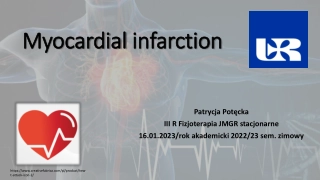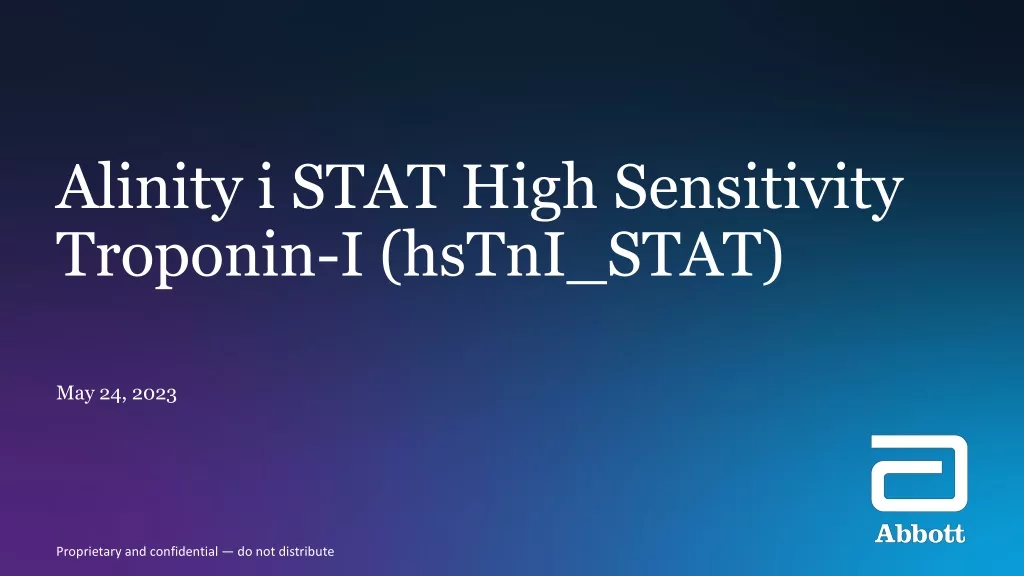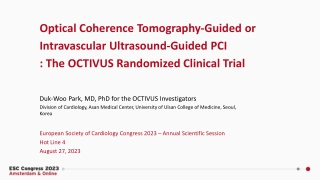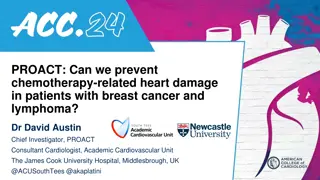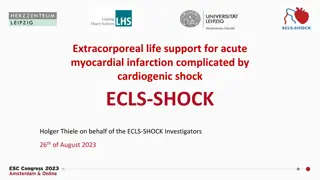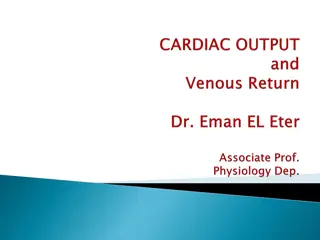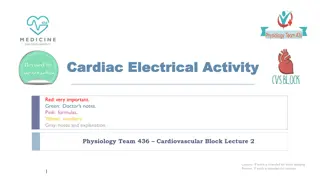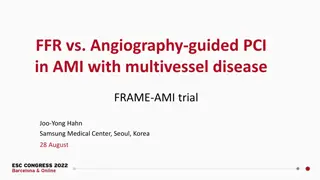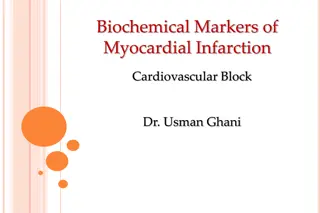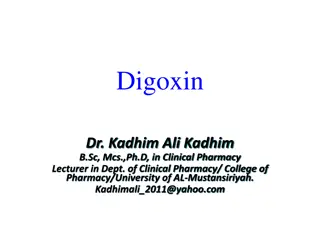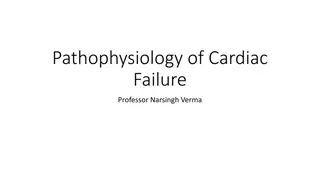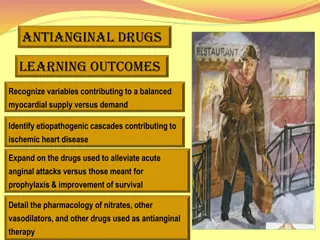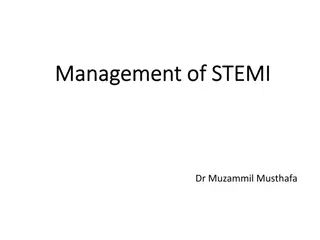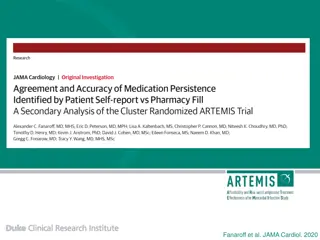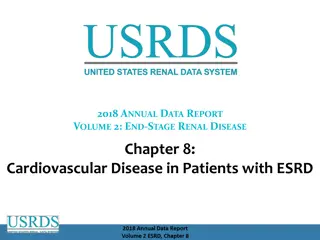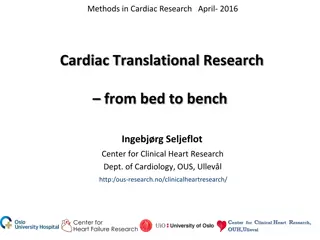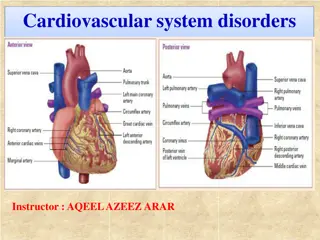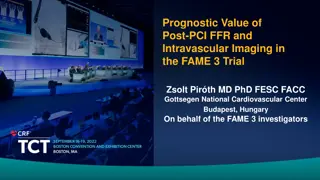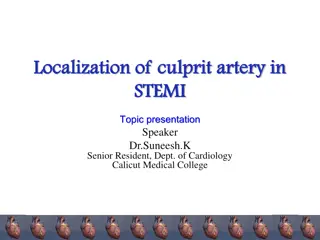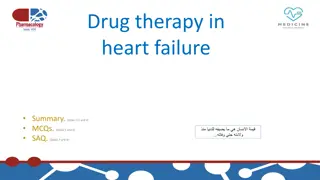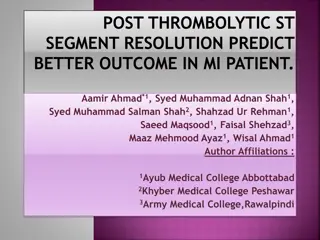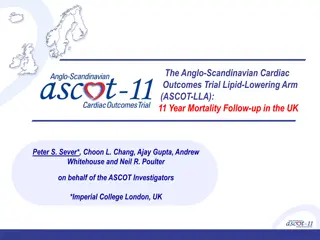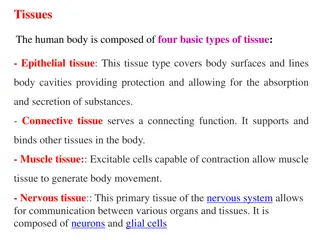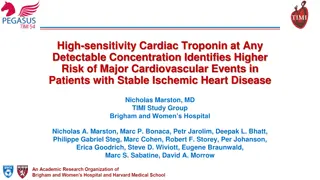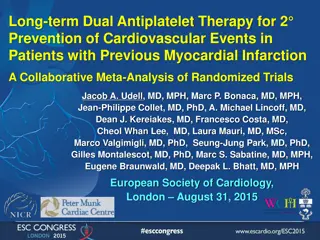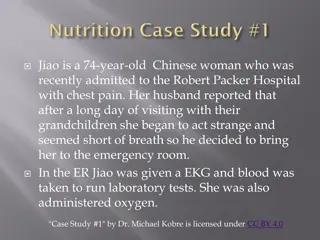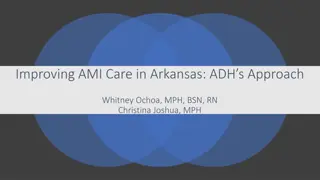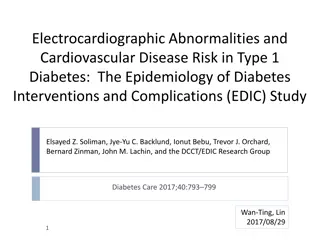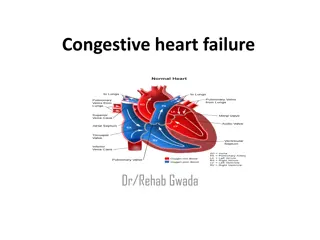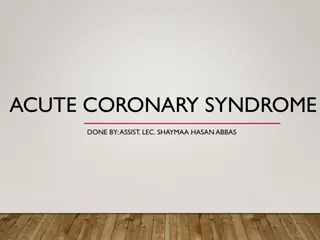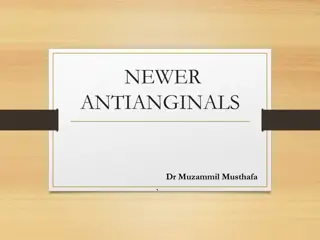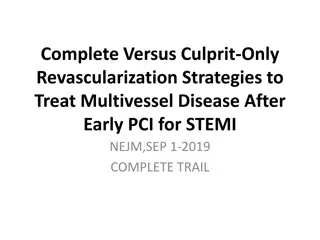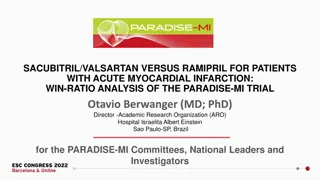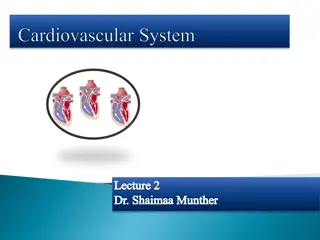Myocardial infarction
Myocardial infarction (heart attack), including its types, causes, symptoms, and first aid techniques. Discover how to recognize the signs of a heart attack and provide immediate care at home or in a hospital setting.
2 views • 14 slides
Alinity i STAT High Sensitivity Troponin-I for Cardiovascular Diagnosis
Alinity i STAT High Sensitivity Troponin-I is a proprietary assay used in diagnosing myocardial infarction (MI) by quantitatively measuring cardiac troponin I in human plasma. This chemiluminescent microparticle immunoassay (CMIA) aids in the detection of MI, a significant aspect in managing heart d
2 views • 30 slides
OCTIVUS Randomized Clinical Trial: OCT-Guided vs IVUS-Guided PCI
The OCTIVUS Randomized Clinical Trial compared the clinical efficacy and safety of Optical Coherence Tomography (OCT)-guided and Intravascular Ultrasound (IVUS)-guided strategies in patients undergoing PCI for significant CAD. The study aimed to determine if OCT-guided PCI is noninferior to IVUS-gui
11 views • 27 slides
Prevention of Chemotherapy-Related Heart Damage in Breast Cancer and Lymphoma Patients: PROACT Study
Dr. David Austin leads the PROACT study aiming to prevent chemotherapy-related heart damage in breast cancer and lymphoma patients using the ACE inhibitor enalapril. The research focuses on the effectiveness of enalapril in mitigating anthracycline cardiotoxicity, crucial for reducing long-term impa
3 views • 19 slides
Evolution in HDL Hypothesis: CSL-112 Infusions in Acute Myocardial Infarction
This study explores the use of CSL-112 infusions in patients with acute myocardial infarction to enhance high-density lipoprotein (HDL) function. By focusing on improving HDL-C function through ApoA-1 infusions, the research aims to enhance outcomes associated with cardiovascular events. The efficac
4 views • 27 slides
Extracorporeal Life Support for Acute Myocardial Infarction Complicated by Cardiogenic Shock
This study explores the use of extracorporeal life support (ECLS) in patients with acute myocardial infarction complicated by cardiogenic shock. The researchers investigate the impact of ECLS on mortality and various secondary endpoints such as renal failure, recurrent infarction, and need for revas
0 views • 20 slides
Cardiac Output and Venous Return in Cardiovascular Physiology
Cardiac output, stroke volume, end-diastolic and end-systolic volumes play vital roles in cardiovascular function. Factors affecting cardiac output include physiological conditions and pathological states like hyperthyroidism and myocardial infarction. Venous return, controlled by mechanisms like Fr
0 views • 27 slides
Cardiac Electrical Activity in Physiology Team's Cardiovascular Block Lecture
Dive into the intricate details of cardiac electrical activity in this lecture led by Physiology Team 436. Explore topics like the cardiac conductive system, action potentials, refractory periods, excitation-contraction coupling, and the effects of autonomic stimulation on heart electrophysiology. D
0 views • 29 slides
Comparison of FFR-guided PCI vs Angiography-guided PCI in AMI with Multivessel Disease: FRAME-AMI Trial
In patients with acute myocardial infarction (AMI) and multivessel coronary artery disease, this study aims to compare fractional flow reserve (FFR)-guided PCI with angiography-guided PCI for non-infarct-related artery lesions. The hypothesis is that selective PCI guided by FFR is superior to routin
2 views • 23 slides
Biochemical Markers of Myocardial Infarction
This lecture covers the criteria for diagnosing myocardial infarction (MI), features of ideal MI markers, the significance of plasma marker changes, and properties of markers such as cardiac troponins, creatine kinase, and myoglobin. It also discusses the new markers used for diagnosing MI and provi
1 views • 29 slides
Congestive Heart Failure: From Pathophysiology to Clinical Practice
Congestive heart failure (CHF) is a condition characterized by systemic and pulmonary congestion due to the heart's inability to pump sufficient blood for the body's metabolism. It is closely linked to age and involves pathophysiology related to preload, afterload, contractility, and heart rate. Man
0 views • 20 slides
Clinical ECG Interpretation Elective: Learning Objectives and Activities
This rotation aims to enhance clinical skills in ECG interpretation with a focus on myocardial and conduction abnormalities, arrhythmias, and tachycardias. Students will engage in e-learning modules, case studies, and literature reviews to master ECG analysis. The course emphasizes patient care, med
0 views • 10 slides
Digoxin Pharmacology and Clinical Use
Digoxin, a cardiac glycoside, is utilized in managing congestive heart failure and atrial fibrillation due to its inotropic and chronotropic effects on the heart. It functions by inhibiting Na,K-ATPase, leading to increased intracellular calcium concentrations and augmented myocardial contractility.
5 views • 23 slides
Pathophysiology of Cardiac Failure and Adaptive Mechanisms of the Heart
Cardiac failure is a condition where the heart is unable to meet tissue metabolic needs despite normal or increased venous return. Causes include decreased contractility, coronary blood flow, damaged valves, and more. Normal resting cardiac output is 5 Lt/mts, with adaptive mechanisms like the Frank
1 views • 35 slides
Antianginal Drugs and Treatment Options
Recognize the variables contributing to balanced myocardial supply and demand, identify etiopathogenic cascades in ischemic heart disease, and learn about drugs for acute angina relief and prophylaxis. Delve into the pharmacology of nitrates, vasodilators, and other antianginal therapies. Explore th
2 views • 18 slides
Overview of Acute Coronary Syndrome and Myocardial Infarction
Acute Coronary Syndrome (ACS) encompasses a spectrum of conditions involving reduced blood flow in the heart. Ischemic Heart Disease (IHD) is a leading cause of mortality worldwide, with ST-elevation myocardial infarction (STEMI) being more common in younger men. Prompt diagnosis, treatment, and adh
2 views • 73 slides
Examining Medication Persistence Methods and Outcomes in Patients Post MI
Understanding medication persistence post myocardial infarction (MI) is crucial for optimizing patient outcomes. The ARTEMIS trial explored variation in P2Y12 inhibitor persistence rates using multiple measurement methods. This study design involved over 11,000 MI patients across 301 US hospitals, w
5 views • 12 slides
Prevalence of Cardiovascular Disease in Adult ESRD Patients: 2016 Data Report
The data report examines the prevalence of cardiovascular diseases in adult End-Stage Renal Disease (ESRD) patients in 2016 by treatment modality and age. It includes information on various cardiovascular conditions such as atrial fibrillation, acute myocardial infarction, coronary artery disease, a
3 views • 25 slides
Insights into Cardiac Research: Metabolic Syndrome and Acute Myocardial Infarction Studies
Explore the latest findings in cardiac research focusing on two critical clinical problems: Metabolic Syndrome (MetS) and Acute Myocardial Infarction. The studies involve human clinical data, blood sampling, adipose tissue biopsies, cell culture studies, thrombus aspiration, gene arrays, and regulat
0 views • 41 slides
Acute Coronary Syndromes: Causes, Symptoms, and Risk Factors
Acute coronary syndromes (ACS) encompass a spectrum of conditions such as unstable angina, non-ST-segment elevated MI (NSTEMI), and ST-segment elevated MI (STEMI) that result from coronary artery occlusion. Risk factors for ACS include family history of heart disease, obesity, smoking, and hypertens
1 views • 20 slides
Prognostic Value of Post-PCI FFR and Intravascular Imaging in FAME 3 Trial
This study investigates the prognostic value of measuring post-PCI Fractional Flow Reserve (FFR) and intravascular imaging in patients with complex 3-vessel coronary artery disease (CAD), focusing on the impact on outcomes such as target vessel failure (TVF), including cardiac death, target vessel m
0 views • 15 slides
Culprit Artery Localization in STEMI: Insights from a Cardiology Presentation
Dr. Suneesh K., a Senior Resident in the Dept. of Cardiology at Calicut Medical College, delves into the crucial role of ECG analysis in identifying the culprit artery during ST-elevation myocardial infarction (STEMI). This presentation covers coronary circulation, blood supply of the heart, prevale
0 views • 83 slides
Pharmacotherapy for Heart Failure: A Comprehensive Review
In heart failure management, drugs play a crucial role in reducing preload and afterload, increasing cardiac contractility, and improving overall outcomes. Common drug classes include diuretics, aldosterone antagonists, ACE inhibitors, ARBs, beta-blockers, and vasodilators. These medications help al
0 views • 8 slides
Thrombolytic ST Segment Resolution Predicts Better Outcome in MI Patients
Acute myocardial infarction (AMI), commonly known as a heart attack, occurs when blood flow to a part of the heart is blocked, leading to heart muscle injury. Resolution of ST segment elevation on electrocardiogram after thrombolytic therapy can predict final infarct size, left ventricular function,
0 views • 24 slides
ASCOT-LLA Trial: 11-Year Follow-up on Atorvastatin Effects
The Anglo-Scandinavian Cardiac Outcomes Trial Lipid-Lowering Arm (ASCOT-LLA) conducted on hypertensive patients investigated the impact of atorvastatin versus placebo on cardiac outcomes. The study revealed a significant reduction in nonfatal myocardial infarction and fatal coronary heart disease wi
0 views • 20 slides
Epithelial Tissues: Structure and Function
Epithelial tissues play crucial roles in the human body, covering surfaces, lining cavities, and forming glands. They are highly cellular and rest on a basement membrane, separating them from connective tissues. Epithelial tissues serve functions such as protection, absorption, secretion, and contra
0 views • 15 slides
High-Sensitivity Cardiac Troponin in Stable Ischemic Heart Disease
Study by Nicholas Marston, MD, and team shows that high-sensitivity cardiac troponin at any detectable concentration is linked to a higher risk of major cardiovascular events in patients with stable ischemic heart disease. The research, conducted through the PEGASUS-TIMI 54 trial, aimed to further u
0 views • 17 slides
Long-term Dual Antiplatelet Therapy for Prevention of Cardiovascular Events
Collaborative meta-analysis explores the efficacy of long-term dual antiplatelet therapy in preventing cardiovascular events in patients with previous myocardial infarction. Trials show heterogeneous results on the benefits and safety of prolonged therapy, with varying recommendations based on patie
0 views • 21 slides
Clinical Cases and Image Findings in Cardiology and Neurology
Explore a collection of clinical cases and image findings covering topics such as widened mediastinum, tracheal deviation, subdural hematoma, myocardial infarction, and arrhythmias. Learn about different diagnostic modalities, operative treatments, and potential complications associated with these c
0 views • 17 slides
Postural Drainage Therapy for Airway Clearance
Postural drainage therapy is an intervention used for airway clearance by mobilizing secretions in specific lung segments towards the central airways. It involves placing the patient in various positions to facilitate gravity-assisted drainage. The therapy includes manual techniques such as percussi
0 views • 13 slides
Medical Case Study: Jiao, a 74-Year-Old Chinese Woman with Myocardial Infarction
Jiao, a 74-year-old Chinese woman, was admitted to the hospital with chest pain and diagnosed with a mild myocardial infarction. She needed surgery due to severe plaque buildup in her coronary arteries. High cholesterol levels led to a restricted diet plan. Language barrier challenges arose when the
0 views • 5 slides
Enhancing AMI Care in Arkansas: ADH's Strategic Approach
Arkansas Department of Health (ADH) is focusing on improving acute myocardial infarction (AMI) care in Arkansas due to high mortality rates. They aim to develop effective strategies, implement timely interventions, and enhance data elements for better patient outcomes. Recognizing the urgent need, A
107 views • 29 slides
Electrocardiographic Abnormalities and Cardiovascular Disease Risk in Type 1 Diabetes
This study examines the association between ECG abnormalities and incident CVD events in patients with type 1 diabetes, focusing on the prognostic significance in a population where CVD develops earlier. Major and minor ECG abnormalities were classified, with cardiovascular events such as myocardial
0 views • 16 slides
Congestive Heart Failure: Causes, Pathophysiology, and Management
Congestive heart failure (CHF) is a condition where the heart cannot pump enough blood to meet the body's needs, often caused by conditions like hypertension and coronary artery disease. Factors affecting cardiac output include preload, heart rate, stroke volume, afterload, and contractility. The pa
0 views • 23 slides
Therapeutic Strategies in Heart Failure Management
Heart failure is a serious condition characterized by inadequate cardiac output. Compensatory responses include sympathetic nervous system activation, renin-angiotensin-aldosterone system stimulation, and natriuretic peptide release. Pharmacologic therapies target salt and water retention, afterload
0 views • 25 slides
Acute Coronary Syndrome: Diagnosis and Immediate Therapies
A 58-year-old man presents with acute severe chest pain, diaphoresis, dyspnea, and risk factors for coronary heart disease. The most likely diagnosis is acute myocardial infarction. Immediate steps include placing the patient on a cardiac monitor, obtaining an ECG, and administering aspirin. Additio
0 views • 19 slides
Newer Antianginals and Cardiomyocyte Metabolism
Chronic angina is a condition marked by impaired quality of life and decreased life expectancy, primarily due to myocardial ischemia. It is characterized by symptoms like tightness, heaviness, and pressure sensation, often located retrosternally. The pathophysiology involves a mismatch between oxyge
0 views • 73 slides
Comparison of Revascularization Strategies in Multivessel Disease After STEMI
Primary PCI is the preferred method for STEMI patients, but treating multivessel coronary artery disease remains a challenge. The COMPLETE trial compared complete revascularization with culprit-only revascularization in patients with STEMI and multivessel disease. The trial included over 4,000 patie
0 views • 25 slides
Comparison of Sacubitril/Valsartan vs. Ramipril in Acute Myocardial Infarction: WIN-Ratio Analysis
The PARADISE-MI trial compared Sacubitril/Valsartan and Ramipril in patients with acute myocardial infarction. The primary outcome of cardiovascular death, heart failure hospitalization, or outpatient heart failure showed no significant difference between the two treatments. Detailed event rates and
0 views • 20 slides
Cardiac Function and Regulation
Define and explore contractility, inotropism, preload, afterload, heart rate, stroke volume, factors regulating them, and the clinical significance of Frank-Starling law in heart failure and hypertension. Discover how neural influences and autonomic innervation affect heart rate and cardiac control.
0 views • 41 slides
